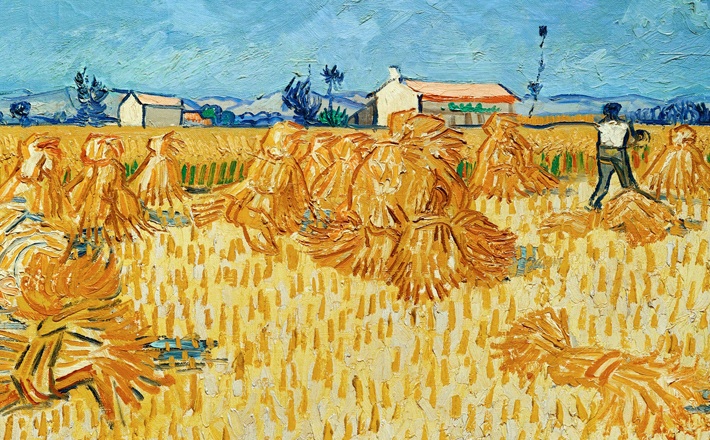Commentary on Galatians 6:[1-6] 7-16
The specific verses from our pericope for this week upon which we will focus is one of a cluster of three texts found scattered throughout Paul’s letter to the Galatians, which may profitably be considered, and preached, together.
Paul’s personal witness to Christian faith: Galatians 6:14-15
In this first text, Paul offers his personal witness or testimony to Christian faith. He does so by way of the image of crucifixion and the cross of Christ, saying that he and the world have been crucified to each other. Paul further explicates this witness by saying that “neither circumcision nor uncircumcision is anything; but a new creation is everything!” (Galatians 6:15). This reflects back to Paul’s statement in 3:28, that in the community of those in Christ there is no longer a distinction between Jew and Greek, i.e. between Jew and non-Jew, between that group whose males are circumcised and that whose males are not. More than that, it underscores and bolsters Paul’s main thesis to the Galatians: it is not that circumcision does not save while non-circumcision does; it is that neither one saves. This in turn constitutes a whole new way of being which absolutely transcends these either/or categories. This Paul calls a new creation: the utterly new way of being for those in Christ, made right with God by faith and thereby set free to be and to live in a new, distinction-free form of life.
Faith working through love
In a closely parallel but not identical passage in the previous chapter of Galatians, Paul had said: “For in Christ neither circumcision nor uncircumcision counts for anything; the only thing that counts is faith working through love” (5:6). The first half of this verse is virtually identical, word for word, with the first half of 6:15, and the same understanding applies; the second half of 6:15 substitutes “a new creation” for “faith working through love.” We need not see an inconsistency here, but rather a distinct emphasis in each text. Characteristic of the new community — the new creation — in Christ is justification by faith rather than by works of the law; to that extent the two verses overlap and are consistent with each other. At the same time, Paul’s ethics, Paul’s explication of what it means to be a new creation and have a new life in Christ, is absolutely interested in and concerned for the doing of good works. Remarkably, these works may be and in truth are the very works of the law. In the middle of an extended discussion of the Christian life and the nature of Christian freedom, Paul writes: “For the whole law is summed up in a single commandment, ‘You shall love your neighbor as yourself.’” (5:14). Living in the new creation in Christ is living the life of love.
Paul himself has been crucified
In what is surely the most profound of the three passages we are considering, Paul writes:
For through the law I died to the law, so that I might live to God. I have been crucified with Christ; and it is no longer I who live, but it is Christ who lives in me. And the life I now live in the flesh I live by faith in the Son of God, who loved me and gave himself for me” (Galatians 2:19-20).
Rather than being crucified to the world as in 6:14, Paul here asserts that he himself has been crucified (from which it follows, of course, that he has been crucified to the world). Paul asserts that he no longer lives and that it is Christ who now lives in him. Nevertheless, his “I” reappears a moment later, and Paul says that he now lives his life “in the flesh,” in his human, mortal life in this world, “by faith in the Son of God.” As the NRSV footnote indicates, this phrase may also be translated “by the faith of the Son of God,” emphasizing Christ’s faithfulness in going to his death on the cross. Paul’s “I” now hovers on the border between being and non-being, existing by the thinnest of margins; the life Paul now lives is “not really his own,” being lived not by his but by Christ’s faith. Paul is as close to being absorbed in Christ as can be.
Questions toward faithful preaching
Marcus J. Borg and John Dominic Crossan state: “Paul was a Jewish Christian mystic.” They go on to say:
A mystic is one who lives in union or communion with God. The difference between union and communion is relatively minor: the first involves a sense of “one-ness” with God; the second, a sense of connection with the sacred that is deep, close, and intimate, even though a sense of “two-ness” remains.1
Borg and Crossan also helpfully relate passages such as ours for this week with what they term “personal,” “internal transformation” in one’s relationship with Christ.2
Regardless of how comfortable, or not, we may be with the language of mysticism, — do we experience personal, internal transformation in our relationship with Christ?
What language do we use to describe that phenomenon? Or perhaps we should ask the prior question: are we comfortable describing, sharing our personal transformative experience of Christ? Do we feel more “at one” with Christ, or do we feel a sense rather of “two-ness” in that relationship? Or sometimes one, other times the other?
Borg and Crossan argue that, for Paul, to be crucified to the world means that he has been crucified to “the world of imperial normalcy,” the world characterized by “‘domination systems,’ societies ruled by a few who used their power, wealth, and ‘wisdom’ to shape the social system in their own self-interest.”3
How do we as persons in Christ describe “the world”? How does our personal, internal relationship with Christ affect our relationship with the world as we define it? Have we been “crucified to it and it to us,” or what language and images would we use to describe the relationship?
May God strengthen us in our relationships with Christ.
Notes:
1 Marcus J. Borg and John Dominic Crossan, The First Paul: Reclaiming the Radical Visionary Behind the Church’s Conservative Icon (HarperOne, 2009), 19, 20.
2 Borg and Crossan, The First Paul, 137.
3 Borg and Crossan, The First Paul, 136, 135.


July 3, 2016